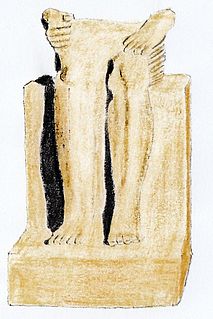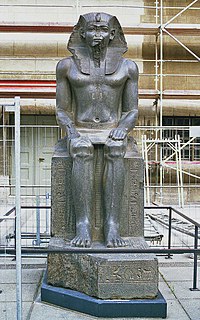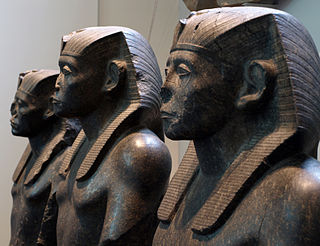Related Research Articles

Amenemhat III, also known as Amenemhet III, was a pharaoh of ancient Egypt and the sixth king of the Twelfth Dynasty of the Middle Kingdom. He was elevated to throne as co-regent by his father Senusret III, with whom he shared the throne as the active king for twenty years. During his reign, Egypt attained its cultural and economic zenith of the Middle Kingdom.

The Middle Kingdom of Egypt is the period in the history of ancient Egypt following a period of political division known as the First Intermediate Period. The Middle Kingdom lasted from approximately 2040 to 1782 BC, stretching from the reunification of Egypt under the reign of Mentuhotep II in the Eleventh Dynasty to the end of the Twelfth Dynasty. The kings of the Eleventh Dynasty ruled from Thebes and the kings of the Twelfth Dynasty ruled from el-Lisht.

Sobekneferu or Neferusobek was a pharaoh of ancient Egypt and the last ruler of the Twelfth Dynasty of the Middle Kingdom. She ascended to the throne following the death of Amenemhat IV, possibly her brother and husband, though their relationship is unproven. Instead, she asserted legitimacy through her father Amenemhat III. Her reign lasted 3 years, 10 months, and 24 days, according to the Turin King List.

Mentuhotep I may have been a Theban nomarch and independent ruler of Upper Egypt during the early First Intermediate Period. Alternatively, Mentuhotep I may be a fictional figure created during the later Eleventh Dynasty, which rose to prominence under Intef II and Mentuhotep II, playing the role of a founding father.

Amenemhat IV was the seventh and penultimate king of the Twelfth Dynasty of Egypt during the late Middle Kingdom period, ruling for more than nine years in the late nineteenth century BC or the early eighteenth century BC.

Nubkaure Amenemhat II, also known as Amenemhet II, was the third pharaoh of the 12th Dynasty of ancient Egypt. Although he ruled for at least 35 years, his reign is rather obscure, as well as his family relationships.

Senusret I also anglicized as Sesostris I and Senwosret I, was the second pharaoh of the Twelfth Dynasty of Egypt. He ruled from 1971 BC to 1926 BC, and was one of the most powerful kings of this Dynasty. He was the son of Amenemhat I. Senusret I was known by his prenomen, Kheperkare, which means "the Ka of Re is created." He expanded Egypt that allowed him to rule over an age of prosperity.

Khakaure Senusret III was a pharaoh of Egypt. He ruled from 1878 BC to 1839 BC during a time of great power and prosperity, and was the fifth king of the Twelfth Dynasty of the Middle Kingdom. He was a great pharaoh of the Twelfth Dynasty and is considered to be, perhaps, the most powerful Egyptian ruler of the dynasty. Consequently, he is regarded as one of the sources for the legend about Sesostris. His military campaigns gave rise to an era of peace and economic prosperity that reduced the power of regional rulers and led to a revival in craftwork, trade, and urban development. Senusret III was among the few Egyptian kings who were deified and honored with a cult during their own lifetime.

Hor Awibre was an Egyptian pharaoh of the 13th Dynasty reigning from c. 1777 BC until 1775 BC or for a few months, c. 1760 BC or c. 1732 BC, during the Second Intermediate Period. Hor is known primarily thanks to his nearly intact tomb discovered in 1894 and the rare life-size wooden statue of the king's Ka it housed.
Neferu was an ancient Egyptian queen of the 12th Dynasty. She was a daughter of Amenemhat I, sister-wife of Senusret I and the mother of Amenemhat II.
Iufni was an ancient Egyptian pharaoh of the 13th Dynasty during the Second Intermediate Period. According to the egyptologists Kim Ryholt and Darrell Baker he was the 7th king of the dynasty, while Jürgen von Beckerath and Detlef Franke see him as the 6th ruler. Iufni reigned from Memphis for a very short time c. 1788 BC or 1741 BC.

Heqaib, also Hekaib or Hekayeb, was an ancient Egyptian nomarch of the 1st nomos of Upper Egypt under king Pepi II Neferkare, towards the end of the 6th Dynasty. He was also an officer in charge of military expeditions in Nubia.
Mersa Gawasis is a small Egyptian harbour on the Red Sea and a former Egyptian port city. The harbour lies at the mouth of Wadi Gawasis, 2 km south of the mouth of Wadi Gasus. 25 km north is the city of Safaga and 50 km south al-Qusair. mersa gawasis coordinates The place was apparently used as a port in the reigns of Senusret I to Amenemhat IV of the 12th Dynasty, and served as a loading point for expeditions to Punt. The harbour was also a starting point for journeys to the mines of Sinai.

The Bust of Amenemhat V is a sculpture showing the head of the ancient Egyptian king Amenemhat V, who ruled at the beginning of the Thirteenth Dynasty. One of the major art works of this period, it is today in the Kunsthistorisches Museum in Vienna with the inventory number ÄS 37.

The Statue of Sobekneferu was a sculpture of the ancient Egyptian queen Sobekneferu, who reigned during the 12th Dynasty.

Sarenput I was an ancient Egyptian official during the reign of pharaoh Senusret I of the 12th Dynasty.

Sarenput II, also called Nubkaurenakht was an ancient Egyptian nomarch during the reign of pharaohs Senusret II and Senusret III of the 12th Dynasty.

Khenmet was an ancient Egyptian king's daughter of the Twelfth Dynasty, around 1800 BC. She is mainly known from her unrobbed tomb containing a set of outstanding personal adornments.

Ita was an Ancient Egyptian king's daughter who lived in the 12th Dynasty around 1850 BC. She is known from the statue of a sphinx found in Qatna in modern Syria. The statue is today in the Louvre. On this statue she bears the titles noblewoman (iryt-p`t) and king's daughter of his body. She is perhaps further known from her burial next to the pyramid of king Amenemhat II at Dahshur. The burial was found intact and contained a decorated wooden coffin with longer religious texts including her name and a set of precious personal adornments, including a richly adorned dagger. It is uncertain whether both women are identical. The location of the tomb might indicate that she was a daughter of Amenemhat II.

Itaweret was an Ancient Egyptian king's daughter who lived in the 12th Dynasty around 1850 BC. She is known from her burial next to the pyramid of king Amenemhat II at Dahshur. The burial was found intact and contained a decorated wooden coffin and canopic box with longer religious texts including her name. Some personal adornments were found in the tomb too. The location of the tomb might indicate that she was a daughter of Amenemhat II, but a final proof is missing. Remarkable is the wooden statue of a swan found in her burial apartments.
References
- 1 2 Grajetzki, Wolfram (2014). Tomb Treasures of the Late Middle Kingdom: The Archaeology of Female Burials. University of Pennsylvania Press. p. 190. ISBN 9780812245677.
- ↑ Biri Fay: The Louvre Sphinx and Royal Sculpture from the Reign of Amenemhat II, von Zabern, Mainz 1996, ISBN 3-8053-1760-3, p. 36-37
- ↑ Biri Fay: The Louvre Sphinx and Royal Sculpture from the Reign of Amenemhat II, von Zabern, Mainz 1996, ISBN 3-8053-1760-3, p. 46-47